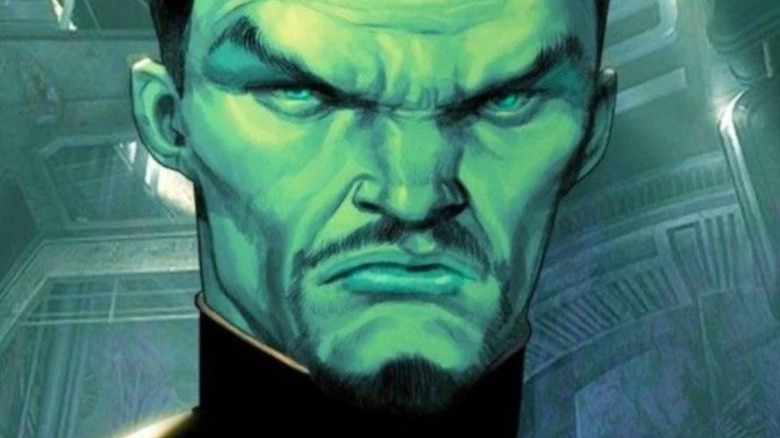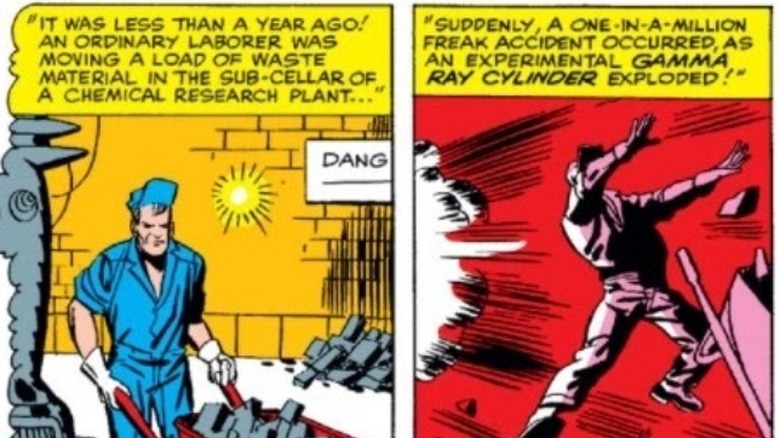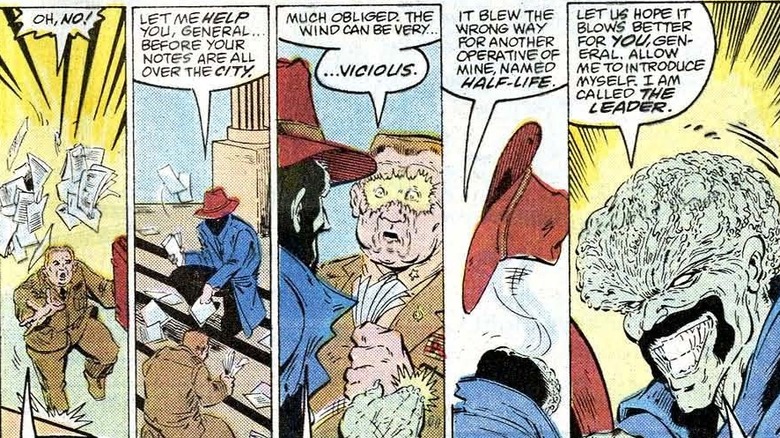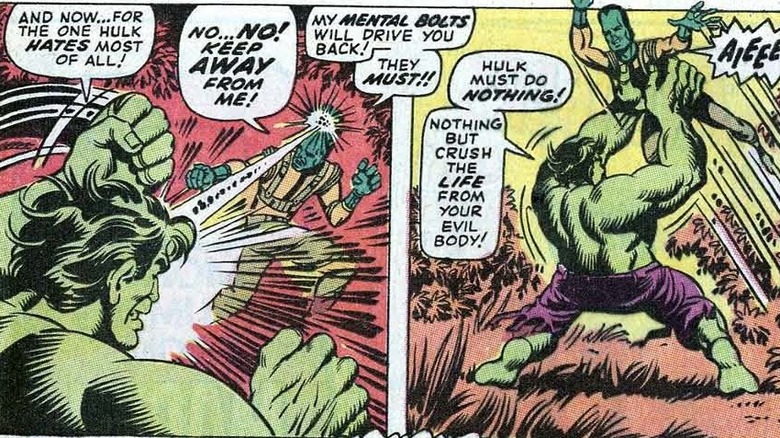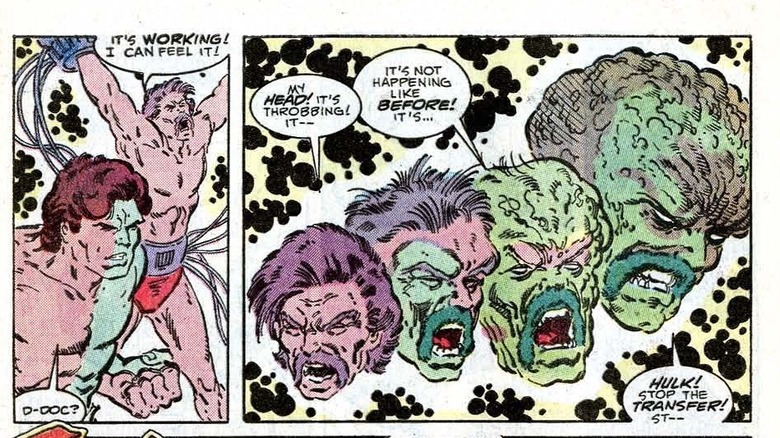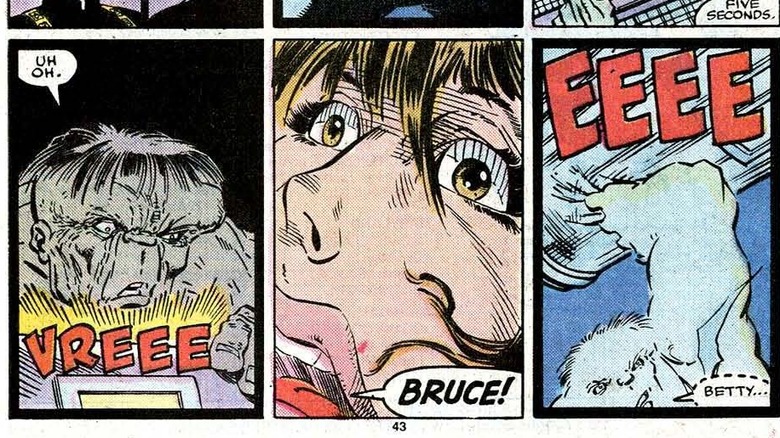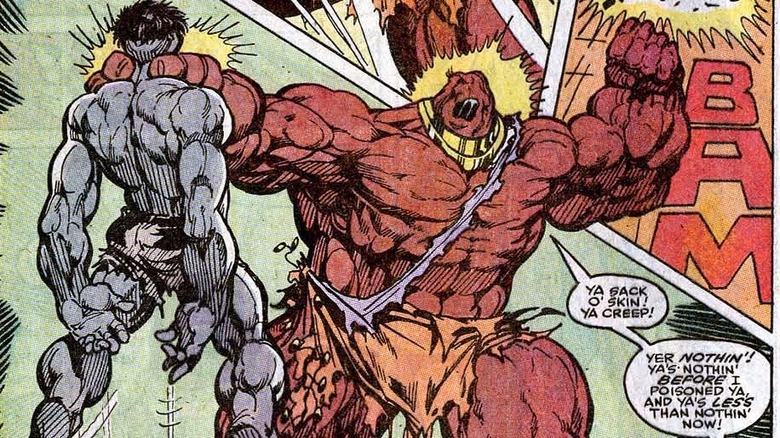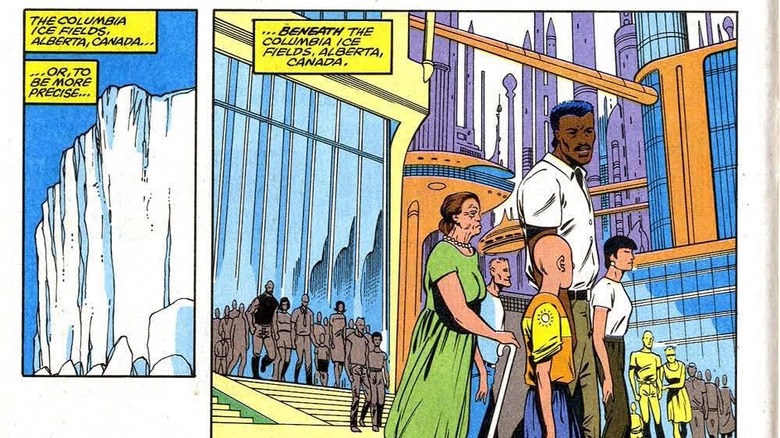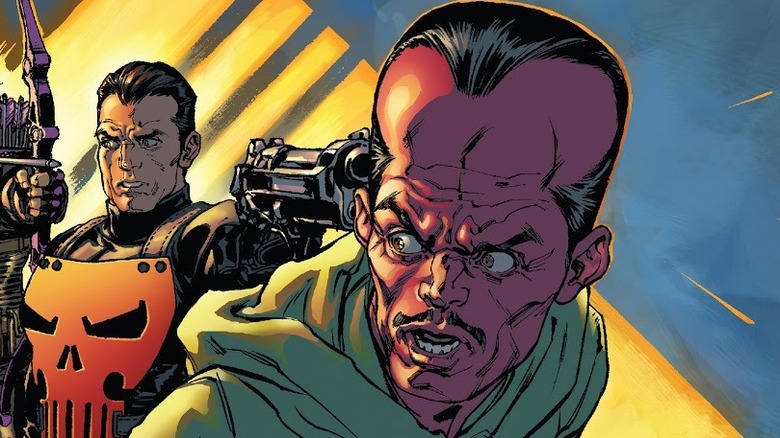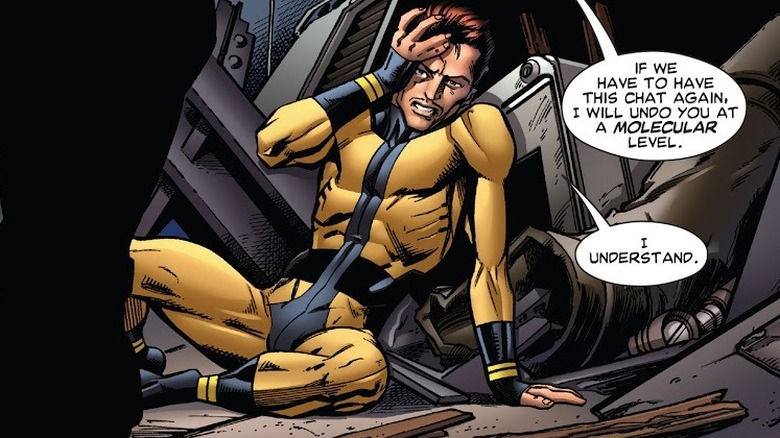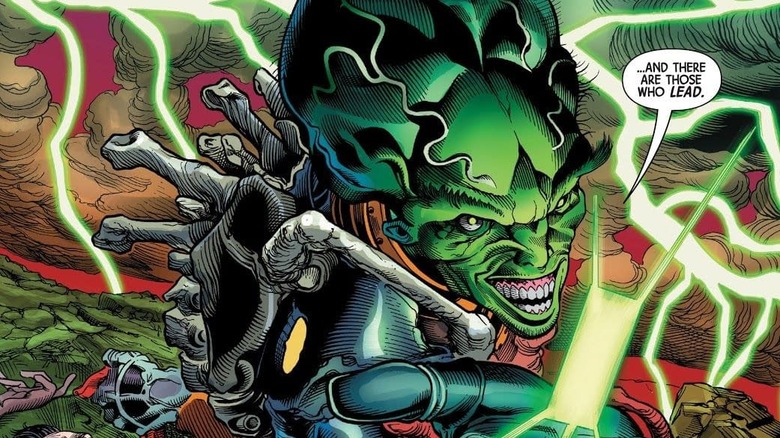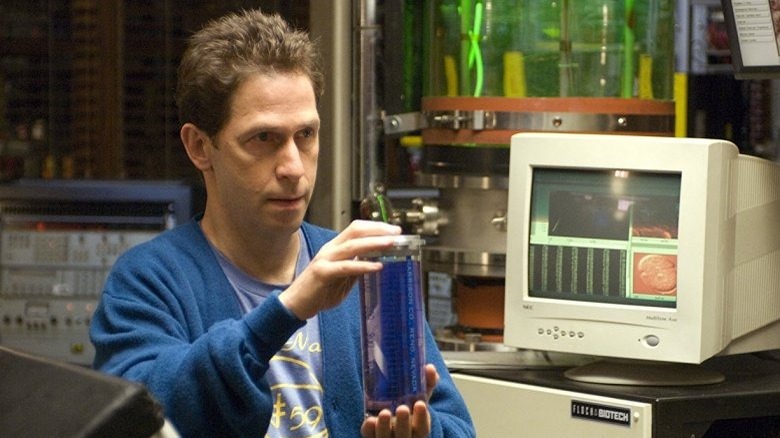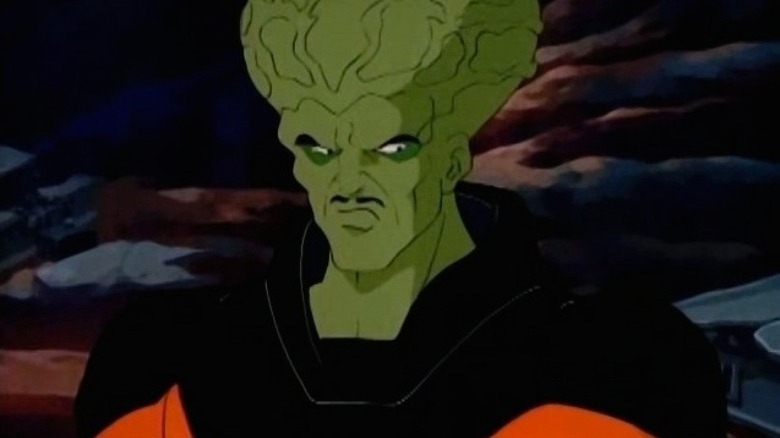The Untold Truth Of Marvel's Samuel Sterns
Comic books were hardly the first medium to employ the now-classic villain archetype of the mad scientist. From Victor Frankenstein of Mary Shelley's 1818 novel "Frankenstein" to Rick Sanchez of "Rick & Morty," these twisted prodigies have been with us for centuries. Often, they serve as reminders that without the guiding hand of conscience, science can be as destructive as any of the problems it hopes to solve. In the world of Marvel Comics, Samuel Sterns, better known by his arrogant codename, the Leader, serves as one such reminder.
Best known as one of the Hulk's most persistent adversaries, Sterns has nevertheless made the rounds of Marvel Comics, crossing swords with heroes including She-Hulk, the Avengers, and the X-Men. As one of Earth's keenest intellects, he's waged war on the entire globe. For a brief time, he even acted in defense of a very specific brand of justice as part of one of Marvel's less official groups of heroes. He's also made impressive appearances on the big screen, as well as in animated media. What made him so evil? Why does he hate the Hulk? And what's up with his giant head? We're here to explain everything you need to know about Samuel Sterns.
The birth of the Leader
In their creation of Samuel Sterns, the late Marvel legends Stan Lee and Steve Ditko did their best to forge a character who was the exact opposite of Bruce Banner. Certain elements of the villain's origin, however, were added much later.
While Sterns makes his first appearance in 1964's "Tales to Astonish" #62, we don't see his face in that issue. Moreover, most of the action here revolves around the work of his agent, the master of disguise known as the Chameleon. In the following issue, we learn that a year before the events of the story, Sterns was a manual laborer who was accidentally exposed to gamma radiation while transporting chemical waste. In the months that followed, Sterns' increased mental capacity became evident, as an obsessive hunger for more knowledge forced him to spend all of his time reading books.
Eventually, the changes occurring inside Sterns became much more physically obvious. One day, as he was reading in the library, he became dizzy and passed out. When he woke up, he discovered his skin had turned as green as the Hulk's. Unlike the green goliath, however, his brain became supercharged instead of his muscles, to the point that his cranium was forced to expand to contain the immense organ.
The Leader's diverse and evolving abilities
As the Leader, Samuel Sterns enjoys an array of superpowers, though exactly what he can and can't do tends to change. In part, this is because his character has undergone a number of radical redesigns. What remains constant, however, is his intellect. Sterns possesses an eidetic, or so-called "photographic" memory, and a level of intelligence that vastly outstrips that of a normal human.
The Leader's psychic abilities are more subject to change. He usually enjoys some degree of telepathy and telekinesis, though not at the level of other Marvel psychics like Jean Grey or Professor X. For example, in the comics of the late '80s and early '90s, the Leader can gain complete control over the minds of his victims, but only after making physical contact. Moreover, his power doesn't work on other gamma-irradiated characters like the Hulk. However, the Leader of the 2012-2014 "Thunderbolts" series can actually project gamma radiation, though he hasn't used this ability since that series ended.
In the 2018 "Immortal Hulk" series, the Leader's powers expand to a truly disturbing degree. Unlike earlier versions of the character, who can take over the minds of anyone but the gamma-irradiated, Sterns can now fully possess any gamma mutate. He can also absorb the minds of others to gain their knowledge, effectively devouring their psyches in the process. The immortal nature of all gamma mutates revealed in "Immortal Hulk" opens up ever vaster possibilities for this criminal mastermind.
Samuel Sterns is the Hulk's arch-nemesis
Like just about any comic book superhero who's been in the funny books long enough, the Hulk has a large rogues' gallery. But of his many villains, none have proven to be as much of a challenge (or as memorable) as the Leader. While things almost always end with the Hulk confronting the mastermind directly, Sterns usually prefers to act through his various agents. Over the years, he's employed villains like the Chameleon, the Rhino, the Abomination, the U-Foes, and his own gamma-spawned Riot Squad against the Hulk. He's also created an army of mindless pink humanoids with malleable bodies. They're perfect for taking on the Hulk, as his strongest punches only make them stretch and bounce back like rubber bands.
Sterns' clashes with the Hulk happen for different reasons. In many of their earliest battles, the Hulk stands in the Leader's way of taking over the world. In other instances, such as in Bruce Jones' 2001-2004 "Incredible Hulk" run, the Leader's ultimate goal is to take over his enemy's body for his own ends.
Oftentimes, however, Sterns is out for simple revenge. A perfect example is 1970's "Incredible Hulk" #124, in which Sterns sends the Rhino to disrupt Bruce Banner's first attempt to wed Betty Ross. He might boast a super-powerful intellect, but he's not above being petty.
The "brainy" Leader
When writer Peter David began what would prove to be a career-defining 12-year run on the "Incredible Hulk" comic, the status quo was a little strange. Basically, there were two Hulks running around who didn't like each other very much: Bruce Banner, who had once again become the thuggish and clever grey Hulk eventually known as "Mr. Fixit," and Banner's old sidekick Rick Jones, who had turned into a green-skinned, mentally limited, long-haired Hulk.
David brought Samuel Sterns back in his second issue, 1987's "Incredible Hulk" #331, which reveals his powers have faded. Sterns strikes a deal with the grey Hulk: He'll help him get rid of the Rick Jones Hulk, in return for the grey Hulk's help in getting his powers back. In the following issue, the grey Hulk lures Jones into an underground lab where his gamma energy is removed and redirected into Sterns.
The plan works, though Sterns is initially believed to have been killed by an explosion. But he does indeed survive, and even takes on a new physical appearance. The long, domed head the Leader sports in earlier stories is gone, replaced by a craggily expanded skull that appears to just barely contain Sterns' massive brain. As a result, Sterns looks kind of like a taller, green-skinned version of the aliens from the 1996 Tim Burton film "Mars Attacks!"
The Leader's brutal triumph in Middletown
Samuel Sterns has endured trash talk from comics fans, and even other fictional villains. After all, while different versions of the Hulk enjoy varying levels of intelligence, most aren't known for their high IQs. Considering the Leader's persona depends so completely on his intellect, it's a little embarrassing that he consistently fails to outsmart such a historically unintelligent hero.
But in fact, those trash-talkers could do with a history lesson. The Hulk suffers arguably his most complete defeat at the hands of the Leader in 1988's "Incredible Hulk" #345, all because of the villain's canny calculation. Sterns lures the Hulk to the small town of Middletown, Arizona by threatening to detonate a gamma bomb there. He further fools the Hulk into believing he has hours to disarm the bomb, then detonates it while it's in the Hulk's hand. The blast kills all but a handful of the town's nearly 5,000 residents. To make matters worse, the Leader kidnaps the irradiated survivors, who become his servants as the Riot Squad. The Hulk is presumed dead as well, though in 1989's "Incredible Hulk" #351, it's revealed he was whisked away at the last moment by wizards from another world, who had been monitoring him for their own reasons.
The consequences of the Leader's actions are far-reaching. In 2001's "Avengers" #39-41, Earth's mightiest heroes face off against a literal army of Hulks, later revealed to have been created with gamma radiation from Middletown's remains.
Sterns' brother is just as evil
Unfortunately for everyone involved, it eventually comes to light that Samuel Sterns isn't an only child. While he first shows up in 1989's "Incredible Hulk" #362 as a scientist at the nuclear research lab where an incognito Bruce Banner gets a job as a janitor, Dr. Phil Sterns is revealed five issues later to be the mentally and physically unstable villain known as Madman.
Unlike his brother, Phil Sterns is something of a stalker to both Bruce Banner and the Hulk. Banner and Phil attended the same graduate school, where Banner was a star pupil and Phil barely scraped by. Later, after the public learns that a gamma bomb turned Bruce Banner into the Hulk, Sterns somehow sees it as a destiny he was robbed of. He goes on to spend years trying to turn himself into a Hulk. He eventually succeeds, having transformed himself into the shapeshifting Madman. As Madman, he both loves and hates the Hulk: He claims to have modeled his life after the Hulk's, yet is simultaneously determined to kill him.
The Leader's lost utopia
Samuel Sterns actually manages to achieve a victory that slips free of most supervillains' grasp: He creates his own utopia.
At some point between the destruction of Middletown in 1988's "Incredible Hulk" #345 and 1992's "Incredible Hulk" #397, Sterns establishes the futuristic city of Freehold in Alberta, Canada, beneath the Columbia ice field. Freehold's population includes scientists, radiation victims, gamma mutates like the Riot Squad, and others. The Leader's stated goal is not to violently force the world to capitulate, as you might expect, but to wait for humanity to destroy itself. At that point, the people of Freehold will emerge to rebuild.
Whether or not Freehold still exists is unclear. After defending Freehold from a HYDRA assault force, the Hulk appears to kill Sterns in 1992's "Incredible Hulk" #400. Sterns is later revealed to have possessed the form of Omnibus, one of the members of his Riot Squad. Omnibus is exiled from Freehold in 1996's "Incredible Hulk" #442, and it's implied he's killed by a polar bear. The last time we see Freehold is when the city is occupied by the alien forces of the Troyjans two years later in "Incredible Hulk" #465.
In Peter David's farewell issue on the title, 1998's "Incredible Hulk" #467, Freehold is destroyed by the Troyjans and their vengeful leader Armageddon in what is described as a "possible" future. So far as Marvel's prime continuity has revealed, however, this has yet to occur.
The rise of Red Leader
In 2008's "Hulk" #1, fans are introduced to the Red Hulk, who has proven to be a popular antihero. He's popular enough, in fact, that he's spawned the Red She-Hulk, and eventually, yes, even the Red Leader.
In the wake of the 2012 line-wide event "Avengers Vs. X-Men," Thaddeus "Thunderbolt" Ross — aka the first Red Hulk — forms a new team of Thunderbolts. Unlike previous incarnations of the team, which were made up either of reformed villains or bad guys otherwise convinced to work toward the greater good, Ross' team is comprised mostly of violent antiheroes like the Punisher, Deadpool, and Elektra. In 2013's "Thunderbolts" #2, it's revealed that Ross is keeping Samuel Sterns, whose powers have been drained from him, in a shipping container. Ross treats him with red gamma energy in order to force him to help the team against his brother, Madman, thus transforming him into the Red Leader.
Red Leader stays with the Thunderbolts after the defeat of Madman, mostly out of fear that Red Hulk will kill him if he does otherwise. But Sterns doesn't stay complacent for long. After the Punisher quits the team in 2014's "Thunderbolts" #27, Sterns uses the mutual distrust between Frank Castle and his former teammates to manipulate them into a conflict. The resulting clash succeeds in splitting the team, though Sterns once again winds up imprisoned.
Samuel Sterns gets cured, ever so briefly
There was a time when Marvel Comics arguably enjoyed an overabundance of Hulks. When a new volume of "Hulk" launched in 2014, there existed Bruce Banner's Hulk, Skaar the son of Hulk, the Red Hulk, Hulkling of the Young Avengers, and not one, not two, but three She-Hulks. So, the super-intelligent version of the Hulk who calls himself Doc Green launches a campaign to rid Earth of just about every gamma mutate — whether they're a good guy or a bad guy — with a cure. Not surprisingly, Samuel Sterns (still the Red Leader at this point) is high on Doc Green's to-cure list.
After fighting off a powerful but mindless gamma mutate, Doc Green initially appears to succeed in curing Sterns of his gamma powers in 2015's "Hulk" #13. But after Doc Green says goodbye, a twist is revealed. To aid him in his quest, Doc Green developed an A.I. calling itself Gammon. Secretly, Gammon begins working against Doc Green's interests, and re-irradiates Sterns after Doc Green cures him. What results is a green-skinned Leader who looks a lot like he did in his earliest "Tales to Astonish" stories.
The immortal Leader
Right before Marvel Comics resurrected the Hulk for the "Immortal Hulk" series, they gave fans a recap of all the times the Hulk has died only to inexplicably return in 2018's "Avengers" #684. In the "Immortal Hulk" series that follows, readers learn that all humans mutated by gamma energy share the Hulk's immortality. Upon their death, every gamma mutate travels to the hellish, otherworldly Below-Place, which is ruled by a powerful cosmic being known as the One Below All.
While it takes him a while to show up and be counted, in 2020's "Immortal Hulk" #34, we finally see Samuel Sterns' own journeys to and from the Below-Place, coupled with recaps of his many deaths. For example, we revisit the time his brain was overloaded by the Watcher's Ultimate Machine in 1965's "Tales to Astonish" #74, and his plunge into molten lava in 1983's "Incredible Hulk" #284.
Eventually achieving a more conscious awareness of the Below-Place's nature, Sterns gathers more power than he's ever wielded before. He can now devour the minds of his victims, an act he performs on Brian Banner, Bruce Banner's monstrously abusive father. He's also able to possess other gamma mutates, and, perhaps most destructively, learns to manipulate the Below-Place enough that he can stop other gamma mutates from being resurrected, should he wish it.
The MCU's Samuel Sterns
2008's "The Incredible Hulk" lays the foundation for Tim Blake Nelson to eventually appear as the Leader in the MCU. In a 2017 interview with Mandatory, Marvel Studios president Kevin Feige said that the idea of using the character still comes up periodically, so the possibility may not be off the table just yet.
Perhaps the most obvious difference between the Samuel Sterns of the MCU and that of the source material is his origin. Unlike the comic book Sterns, who starts off as a laborer whose interest in science arrives after his gamma accident, the Sterns of the MCU is an accomplished scientist.
There are similarities between the two versions of Sterns, however, long before the movie iteration's head wound is exposed to Bruce Banner's irradiated blood. Unlike Banner, who wants only to cure himself, the cinematic Sterns sees limitless possibilities in the application of Banner's blood. In fact, Sterns is in the middle of arguing about it with Banner and Betty Ross when they're interrupted by General Ross' soldiers. Sterns also doesn't seem to suffer from any moral compunctions when it comes to empowering Blonsky with Banner's blood. Furthermore, there's the online correspondence he has with Banner before they meet. In the comics, Sterns likewise disguises himself as the mysterious "Mr. Blue" while communicating with and manipulating Banner, though this happens long after he'd already transformed into the Leader.
Samuel Sterns gets animated
While we have yet to see a live-action take on the green-skinned Leader, the villain has made plenty of appearances on television through animated media. His first appearance, in which he's voiced by the late Gillie Fenwick, arrived in the 1966 "The Marvel Super Heroes" cartoon. This series lifts images directly from the comics for its relatively crude (but weirdly charming) animation.
While Sterns only appears in a single episode of the 1982-1983 "Incredible Hulk" cartoon, voiced by Stan Jones, he's a much more persistent thorn in the Hulk's side in the 1996-1997 series of the same name, voiced by Matt Frewer. Here, his origin is much more closely tied to that of the Hulk's than in the comics, and many of the hero's enemies act as his servants.
All in all, James Arnold Taylor has portrayed Samuel Sterns more than any other single voice actor. Taylor, likely best known as Obi-Wan Kenobi on "Star Wars: The Clone Wars," has voiced the Leader on "Ultimate Spider-Man: Web Warriors," "Hulk and the Agents of S.M.A.S.H.," and "Avengers Assemble." Taylor isn't the only sci-fi heavyweight voicing this villain: Jeffrey Combs, known for his work across various "Star Trek" series, played the Leader on "Avengers: Earth's Mightiest Heroes." Bill Hader is the most recent actor to give voice to Sterns, in Hulu's "M.O.D.O.K." series.
